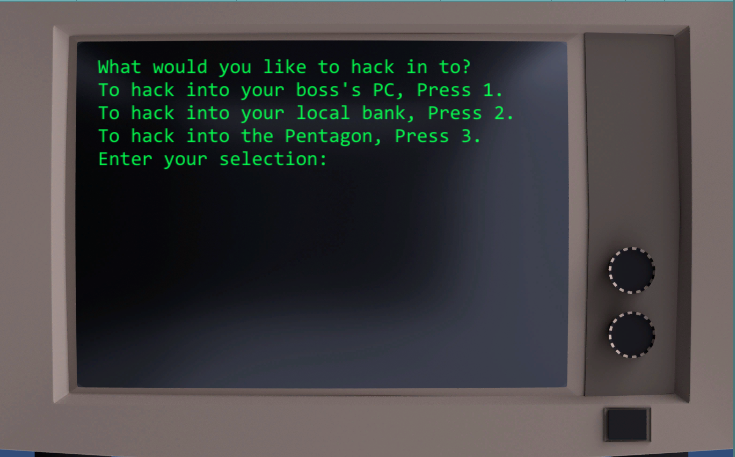- Terminal Hacker (itch) (starsnomoon) Mac Os Free
- Terminal Hacker (itch) (starsnomoon) Mac Os Update
- Terminal Hacker (itch) (starsnomoon) Mac Os Download
Transcript
Terminal Hacker Run game This was the first project of the Udemy course 'Complete C# Unity Developer 3D: Learn to Code Making Games' with additional screens and mechanics. Back from a long hiatus from your blog, I see there's much to catch up with. That was a long but fun read. As to this sentence of yours, 'That is, unless a sudden web standard reform surprises me by ditching the current mess and starting over from a clean slate based on sane programming principles and modern web use cases', won't happen anytime soon.

This is senior editor Dan Moren. We take networking for granted these days, but it's still a complicated beast. If you want to go under the hood, Apple includes a suite of tools on your Mac to help you troubleshoot networking issues; they're all included in the Network Utility app, which you can find in System/Library/CoreServices/Applications—though it's probably easier to simply type 'Network Utility' into Spotlight.
When you first launch Network Utility, you'll see a single window with a variety of tabs, each of which offers different information. The first tab, Info, provides information about your own computer, offering a drop-down menu of all your network interfaces—for example, if you have both wired ethernet and Wi-Fi connections. When you select one, you'll see the Hardware Address, associated IP, speed, and information about how much data is going in and out of that particular connection. Most often you'll refer to the info here when troubleshooting issues.
Next, we'll take a look at the Ping tab. This tool sends packets of data over the network to a specified address, which can help you figure out if the remote server in question is encountering problems. To check if there are issues on your local network, you can ping your router's address, which you can find in the Network preference pane. By default, ping sends 10 packets, and then reports how many of those packets successfully arrived at the destination and how long it took those packets to make the trip. If you're losing a lot of packets, or they take a long time to arrive, it's a good indication that there's a network slowdown. If you're getting errors about all your packets, there's probably a network problem on your own side. Gibbs runner (gibbshybrid) mac os.
Terminal Hacker (itch) (starsnomoon) Mac Os Free
The Lookup tool is a handy one if you've ever had questions about just where an IP address comes from. Think of it like a phone book: Enter any domain name to get the corresponding IP address (or vice versa). On the off chance that you find yourself poring over network logs or wondering about where an email came from, this tool might provide some illumination.
If you've ever wanted to feel like your typical movie hacker, the Traceroute tab might scratch that itch. Think of it as a more detailed version of the ping tool—not only does it send packets to a specified server, but it also charts all the stops that packet makes. (It's a bit like tracking a train's route.) If there's a particular server in the chain that's slowing your connection down, this can help you suss it out—though doing something about that is probably out of your reach; you may wish to talk to your ISP. Miworld mac os.
Terminal Hacker (itch) (starsnomoon) Mac Os Update
Finally, the Whois tool is the place to go if you're wondering who owns a particular domain name. Just enter the domain name and scroll down to find a full listing about its owner—though be aware many registrars these days offer tools to anonymize domain name listings, so you may not find exactly what you're looking for.
Terminal Hacker (itch) (starsnomoon) Mac Os Download
Network Utility has a few additional tools that can be handy for networking troubleshooting, but they require a bit more in the way of know-how. Still, you should feel free to play around with them and see what you can learn. This is senior editor Dan Moren. Breath of warfare mac os. Thanks for watching.
